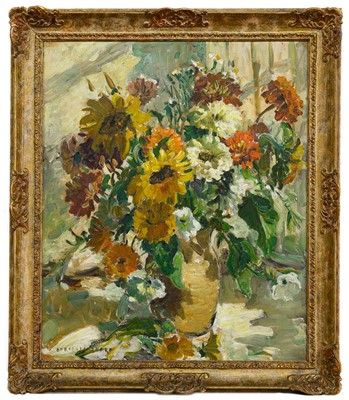10th Apr, 2024 13:00
British & International Pictures
* DOROTHEA SHARP ROI RBA (BRITISH 1874 - 1955)
STILL LIFE OF FLOWERS IN A VASE
oil on board, signed,
framed
image size 61cm x 51cm, overall size 72cm x 62cm
Note: Dorothea Sharp was born on 10th January 1873 into a Quaker family in Dartford, Kent. The family timber business had been established since 1800 and its success afforded Dorothea a certain financial comfort and independence and even though her parents did not really approve, Dorothea wanted to be an artist from an early age. She enrolled at the Richmond School of Landscape Painting in 1894 under the tutelage of Charles Edward Johnson (1832-1913). Preferring to work in oil, she spent much of her time painting outside making rapid notes in her sketchbook, which she worked up later in the studio. This was to be a method which she refined throughout her career and was ideally suited to her style and choice of subject. Shortly after the untimely death of her father in March 1900, Dorothea set off for Paris with her mother Emily. Here she saw first-hand the work of the Impressionists and in particular that of Claude Monet (1840-1926) which was to have a profound and lasting effect on her work. She wrote in The Student's Book of Oil Painting, published in 1947: 'I think the young painters of this decade little realize what we owe to those great masters of The French Impressionist School.' Sharp also came to know and love the work of some of the American painters who were in Paris at the same time, notably Frank Weston Benson (1862-1951) and Carl Frieseke (1874-1939). Upon her return to England, her reputation grew and the bright and bold depictions of children playing feeding ducks, playing at the seaside or picking flowers became more and more popular. Her colourful compositions were ideal for use as posters, which by the 1930s had become an effective and popular form of advertising. By the 1940s Sharp was famous; she had exhibited widely at many leading galleries (and over a period of 47 years at the Royal Academy alone) and her work had been purchased by an admiring public throughout the Empire. She had travelled extensively from the south of France to Algiers and from St Ives (where she spent the war years with her companion Marcella Smith) to Sussex and her circle of friends included many of the leading artists of the day. Sharp's paintings were in many ways unique, but also reflected the changing style of the times. Her rapid, confident brushstrokes were almost sculptural in the way the paint was applied to canvas, but always bound together by an innate understanding and love of colour. Weakening eyesight and creeping arthritis had begun to take their toll by the 1950s and Dorothea and Marcella moved into Blomfield Road where she died on 17th December 1955.
A condition report is offered as an indication of any issues visible to the naked eye. As none of our staff is a professional conservator or restorer, buyers must satisfy themselves in respect of condition and McTear’s can provide contact details of local professionals who can provide fully comprehensive expert reports, usually for a modest charge. The condition report does not form part of any contract between McTear's and the buyer, and all lots are offered "as is" in accordance with our Terms of Business available on our website.
Sold for £8,000
Estimated at £6,000 - £8,000
Request a free auction estimate
Complete the form below and one of our specialists will get back to you.



